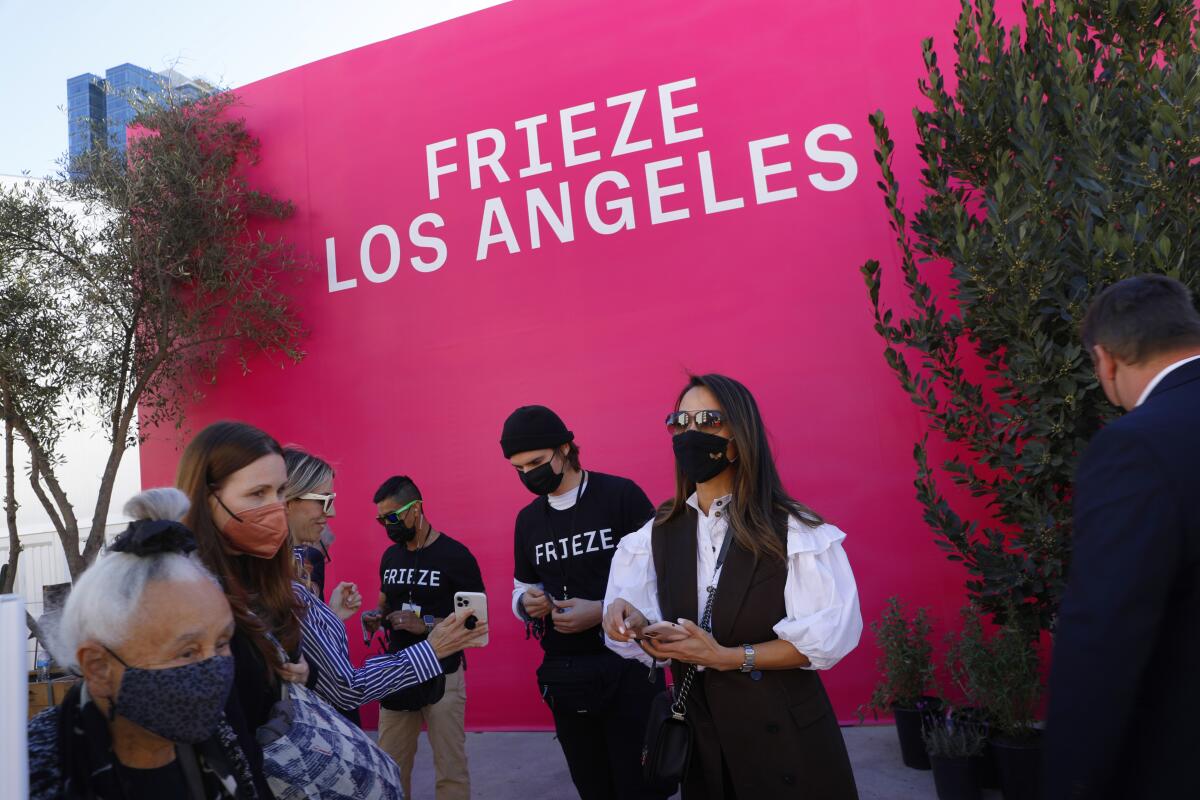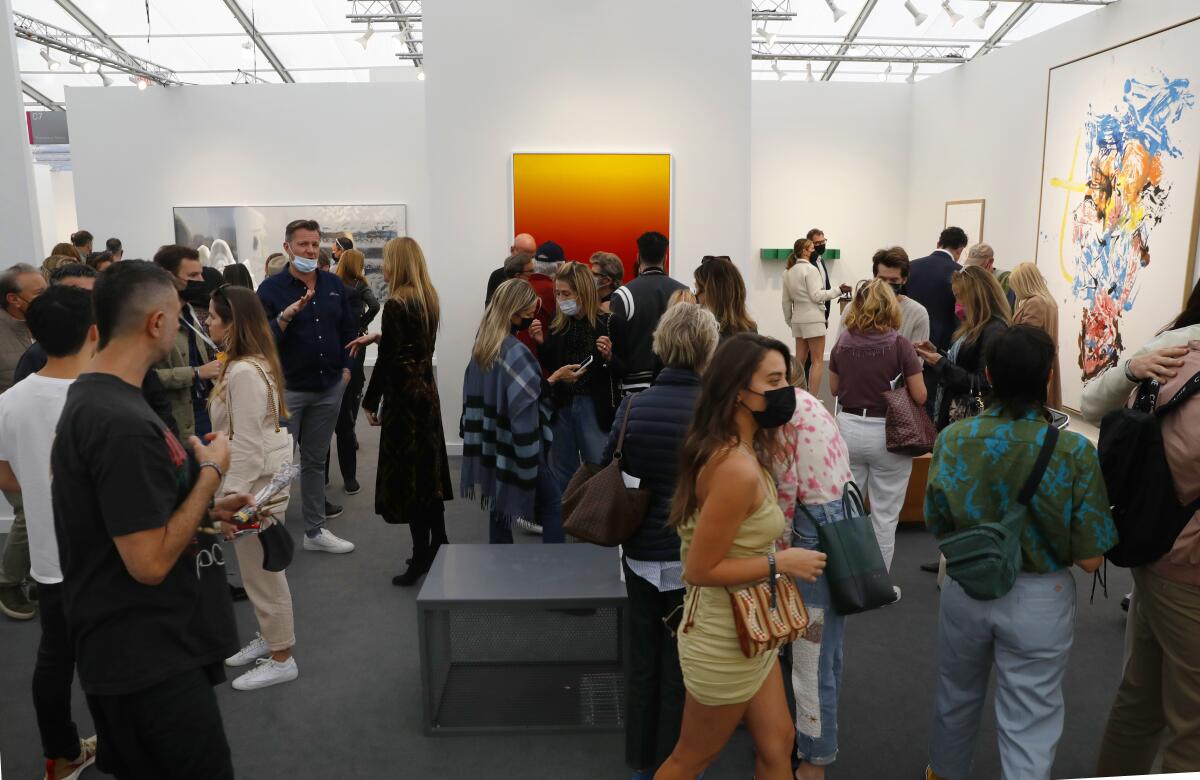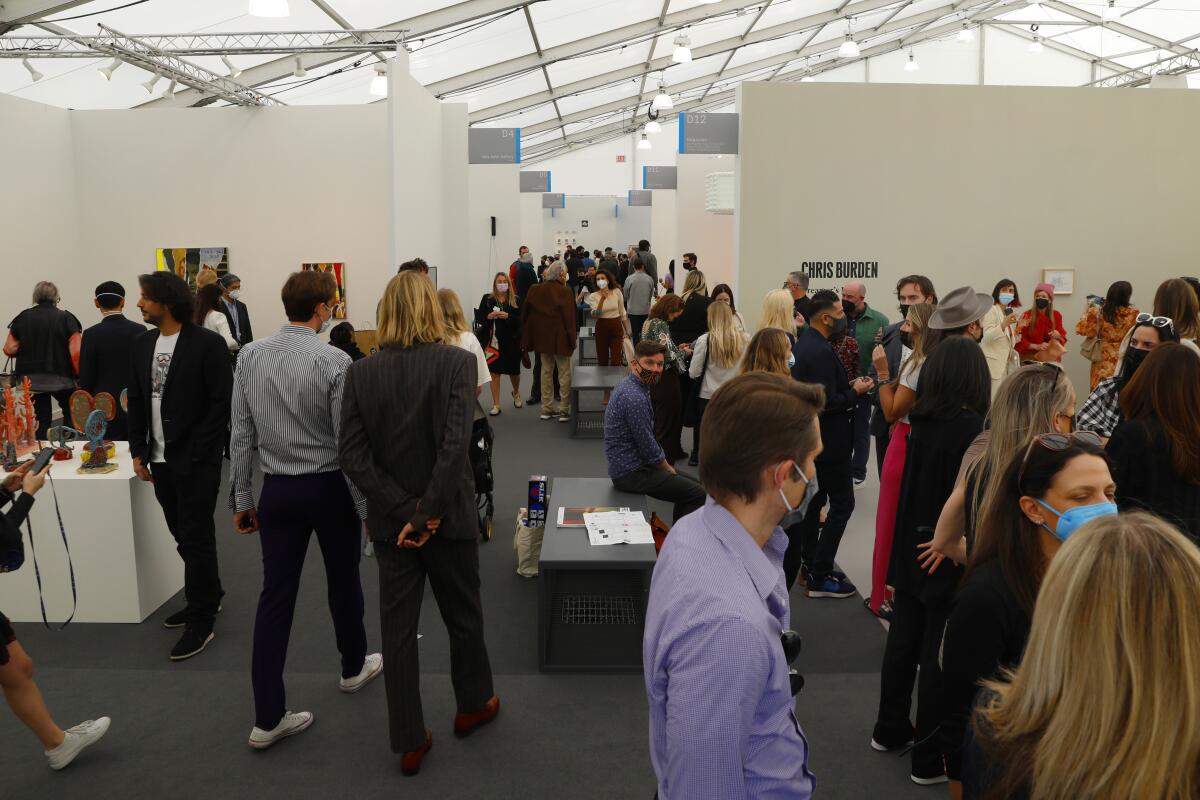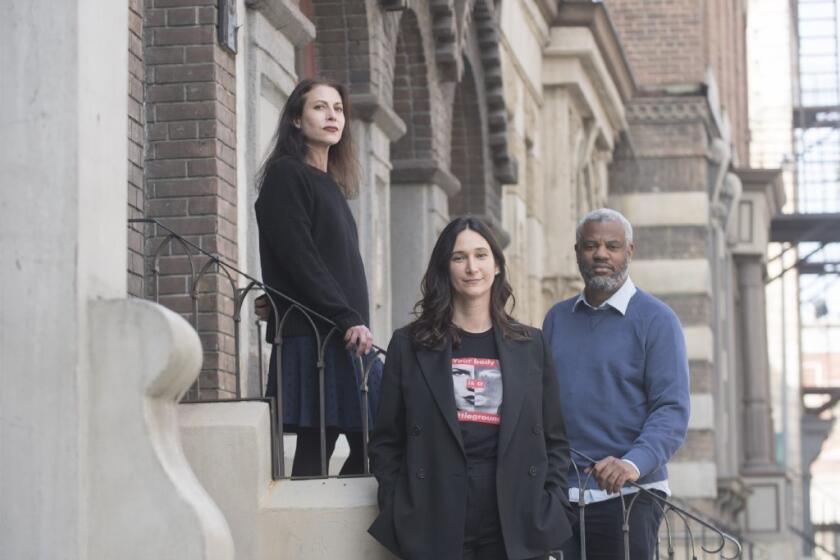Frieze Los Angeles returns, reawakening the art fair scene

- Share via
I’ve covered art fairs for years, traversing more custom-built tents, colorfully dressed crowds and hive-like mazes of mini-exhibitions than I care to remember. But never have I witnessed an actual sale take place, let alone one involving a major Los Angeles artist at a mega gallery.
The Frieze Los Angeles art fair opened on Thursday for previews, and among the exhibitors, Gagosian was showing a large-scale sculptural installation by Chris Burden, “Dreamer’s Folly” (2010). It’s the first time the work, a cast-iron, gazebo-like structure with benches inside that visitors can sit on, has been shown in the U.S. Burden sourced architectural components in the piece from the same person he purchased the street lamps from for his “Urban Light” sculpture, which sits in front of the Los Angeles County Museum of Art.
Gagosian Beverly Hills Senior Director Deborah McLeod was telling me all this when, suddenly, she stopped mid-sentence, making urgent eye contact with two passersby who’d been lingering nearby waiting to chat with her.
“I’ll be right back,” she said, and darted over to them.
They huddled. There was a round of hushed whispers, then a few head nods. Seconds later she reappeared, giddy. “We sold it, we just sold it!” she said of the Burden work, stamping her Gucci sneakers on the floor. She wouldn’t say who the buyers were or how much it sold for, exactly, but the piece will go to “a major European institution,” she said, “so everyone can see it! So exciting.”
Welcome to an energized, eager edition of Frieze Los Angeles 2022.
The art fair — which relocated from its former home at Paramount Pictures Studios to a tent next to the Beverly Hilton — felt less celebrity-studded and Hollwoody this year. James Corden and Owen Wilson were among those roaming the tent floor when the fair opened, but there appeared to be fewer celebrities in attendance compared to previous years as the fair got underway. (Kendall Jenner, Will Ferrell, Gwyneth Paltrow, Leonardo DiCaprio and Pierce Brosnan showed up later.)
There was, however, a celebratory vibe, an eagerness, to the event. A new crop of East Coast galleries is expanding into L.A., for one, many of them having announced their debuts or opened new spaces within the last few weeks. And the event was a reawakening of sorts for the L.A. art fair scene, which was in full swing for the first time since spring 2020.

“It’s lovely, it’s fantastic, it’s wonderful,” said James Corden at a VIP breakfast before the fair opened. “It’s just nice to be looking at people again. I hope the trajectory continues.”
The VIP breakfast — for artists, exhibitors, museum world leaders, collectors and others — took place in the Beverly Hilton’s Wilshire Garden. The event had an elegant, garden party vibe, with its smattering of cocktail tables, mini-quiches and arrangements of white roses, all under a translucent tent with piano music playing in the background.
“We’re a perfect fit for Frieze,” Beverly Hills Mayor Robert Wunderlich said at the breakfast. “Arts and culture is part of our DNA.”
But not everyone agreed. “I wish it was on the Paramount lot, that they’d do something as expansive as L.A. itself,” Paul Schimmel, former MOCA chief curator, told The Times.
Speaking of expansive: The Frieze tent itself — actually three connected tents, again this year designed by Why Architecture’s Kulapat Yantrasast — is 40% bigger than in previous years. It houses 100 exhibitors representing 17 countries (there were 77 last time, in 2020). Frieze expects about 35,000 attendees over the total of four days.
All the expected blue-chip galleries were there, including Blum & Poe, David Kordansky, Sprüth Magers and Hauser & Wirth. But the East Coast galleries moving into L.A. were generating much of the buzz. There are at least nine of them, including Sean Kelly, Lisson Gallery, Pace, the Hole, Karma, Albertz Benda, David Zwirner, Danziger and Sargent’s Daughters in collaboration with Shrine. (There goes parking in Hollywood.) (Even more so.)
“It’s incredibly exciting,” private dealer Graham Steele, formerly a partner at Hauser & Wirth, said over breakfast. “There’s a unique mix in the L.A. landscape among artists, collectors and the museum infrastructure, which is a draw — plus, the weather’s nice.”
When New York’s Sean Kelly debuts on Highland Avenue in Hollywood this spring, the gallery will feature a solo exhibition by British artist Idris Khan. The artist’s work was on view in Sean Kelly’s Frieze booth. One work was as ink-stamped painting on three, layered glass panels, transparent all the way through, so that the text radiates outward in a starburst-like effect. They speak to collapsing moments of time.
“I think L.A. is gaining critical mass,” Kelly said. “Not just as a community of artists but as a major destination museologically and from a gallery perspective. It just seems like it’s the right moment.”
Lisson Gallery, which has outposts in New York, London and Shanghai, will open a 8,000-square-foot-plus space in Hollywood this fall in a former nightclub. The gallery’s move to L.A., Chief Executive Alex Logsdail said, was driven by its artists, many of whom want shows on the West Coast. “There are so many artists here,” he said. “Artists want other artists to see their shows — it’s important for dialogue and community.”
Mega-gallery Pace (with several locations internationally) earlier this month announced it was merging with L.A.’s Kayne Griffin gallery on La Brea Avenue in Mid-City — the two share a love of the Southern California Light and Space movement as well as representation of artists such as Mary Corse, Robert Irwin and James Turrell. In April, the 15,000-square-foot L.A. space, with elements designed by Turrell, will become Pace’s primary West Coast home (there’s also a gallery in Palo Alto). Founding partners Bill Griffin and Maggie Kayne will be managing partners at Pace.
Pace’s April opening will feature a solo exhibition of new paintings by filmmaker and artist Julian Schnabel. But for Frieze, Pace showed Jeff Koons’ “Gazing Ball (Antinous-Dionysus)” (2013), a classical bust made from plaster with a blue orb on its head, new works on paper by David Byrne and a sculptural piece by French street artist and photographer JR, among other work.
“We come in peace!” joked Pace CEO Marc Glimcher of the move into L.A. “And whatever I did, I’m sorry!” Then: “Seriously, partnership and collaboration is the path forward in the art world.”

The art fair itself is expanding. Frieze Seoul will debut in September. The move, said Tina Kim of Tina Kim Gallery, will likely galvanize a small but “hungry” collector base there. “Seoul has become a big destination, a global capital for art,” she said. “There’s a small number of private collectors and they’re eager to see and learn more.”
Last month, Frieze canceled its free, outdoor sculpture exhibition that was to be held in a nearby Beverly Hills park due to Omicron-related delays. An area of the fair called the BIPOC Exchange, organized by L.A. artist Tanya Aguiñiga and situated in the hotel’s Wilshire Garden, is now Frieze’s “forward-facing” offering, free to members of the public who wouldn’t necessarily splurge on a fair ticket ($75-$95 each day for weekend general admission). It features 10 L.A. nonprofits led by or serving BIPOC communities. The organizations span artistic disciplines.
The area had potted plants delineating booth spaces instead of walls and with a makeshift stage, outlined on the ground with fresh flowers, for performances and workshops. The skid row nonprofit Urban Voices Project will host a singing performance there; Tierra Del Sol, which works with individuals with disabilities, will stage poetry readings.
“I wanted to build a space that’s communal,” Aguiñiga said, “where we could bear witness to one another’s work.”
The BIPOC Exchange is part of Frieze Projects, which also includes about half of the works from the canceled sculpture exhibition. The works appear throughout the fair tent as well as in public areas of the hotel.
Glenn Kaino’s “Revolutions” is one of them, on view in the tent. It’s a circular enclosure made of metal bars that, when tapped, plays the melody from U2’s “Sunday Bloody Sunday.” A large-scale sculpture by Woody De Othello, “Fountain,” appears outside, by the tent entrance. It’s a faded-blue, bronze work of three metal pipes that appear melted and intertwined. It speaks to environmental issues such as drought and clean water as well as pandemic-era hand washing, the artist said.
Act I, Scene I: A contemporary art fair, outdoors.
The Focus L.A. section of the tent, curated by Lucas Museum of Narrative Art’s Amanda Hunt, features 11 galleries that have been in operation for 15 years or less.
“I wanted to privilege galleries and shows — and story lines — that are lesser known,” Hunt said. “Like Rodrigo Valenzuela’s work, there’s a through-line about labor, and 84-year-old artist Ben Sakoguchi’s work is about being in a Japanese internment camp, his lived experience.”
A work by 95-year-old Betye Saar, at Roberts Projects, may have summed up the fair-wide sense of optimism and expansion best. It’s a reinterpretation of the L.A. assemblage artist’s Los Angeles public mural, “L.A. Energy,” a city-commissioned work that occupied a 5th Street wall downtown from 1983 to 1987.
Saar painted a new version of the mural on the exterior of the gallery’s booth. The scattering of symbols — a sun, a moon, fans, the artist’s hand, along with the letters L and A, all in bright colors over a nude backdrop — are rendered in the exact color palette of the original mural.
It’s at once soothing and invigorating.
“It’s 39 years later,” said gallery co-owner Julie Roberts. “And what she’s saying — she feels like the energy has really come back to the city, post-COVID.”
And, perhaps, to the art fair scene too.
More to Read
Updates
3:35 p.m. Feb. 18, 2022: This article has been updated to reflect the announcement of the David Zwirner gallery’s Los Angeles expansion.
The biggest entertainment stories
Get our big stories about Hollywood, film, television, music, arts, culture and more right in your inbox as soon as they publish.
You may occasionally receive promotional content from the Los Angeles Times.












